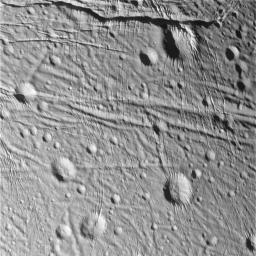
|
Sliced-up Craters
- Click the image above for a larger view
- Full-Res JPEG (1024 x 1024) (192.5 kB)
- Full-Res TIFF (1024 x 1024) (1.1 MB)
Caption:
During its very close flyby of Enceladus on March 9, 2005, Cassini took high resolution images of the icy moon that are helping scientists interpret the complex topography of this intriguing little world.
This scene is an icy landscape that has been scored by tectonic forces. Many of the craters in this terrain have been heavily modified, such as the 10-kilometer-wide (6-mile-wide) crater near the upper right that has prominent north-south fracturing along its northeastern slope.
The image has been rotated so that north on Enceladus is up.
The image was taken in visible light with the narrow angle camera from a distance of about 11,900 kilometers (7,400 miles) from Enceladus and at a Sun-Enceladus-spacecraft, or phase, angle of 44 degrees. Pixel scale in the image is 70 meters (230 feet) per pixel.
A stereo version of the scene is also available (see PIA06216 ). The image has been contrast-enhanced to aid visibility.
Background Info:
The Cassini-Huygens mission is a cooperative project of NASA, the European Space Agency and the Italian Space Agency. The Jet Propulsion Laboratory, a division of the California Institute of Technology in Pasadena, manages the mission for NASA's Science Mission Directorate, Washington, D.C. The Cassini orbiter was designed, developed and assembled at JPL. The magnetometer team is based at Imperial College in London, working with team members from the United States and Germany.
For more information about the Cassini-Huygens mission visit http://saturn.jpl.nasa.gov . The magnetometer team homepage is http://www.imperial.ac.uk/research/spat/research/cassini/ .
Cataloging Keywords:
| Name | Value | Additional Values |
|---|---|---|
| Target | Enceladus | |
| System | Saturn | |
| Target Type | Satellite | |
| Mission | Cassini-Huygens | |
| Instrument Host | Cassini Orbiter | |
| Host Type | Orbiter | |
| Instrument | Imaging Science Subsystem (ISS) | |
| Detector | Narrow Angle Camera | |
| Extra Keywords | Crater, Grayscale, Rotation, Visual | |
| Acquisition Date | ||
| Release Date | 2005-03-24 | |
| Date in Caption | 2005-03-09 | |
| Image Credit | NASA/JPL/Space Science Institute | |
| Source | photojournal.jpl.nasa.gov/catalog/PIA06217 | |
| Identifier | PIA06217 | |
